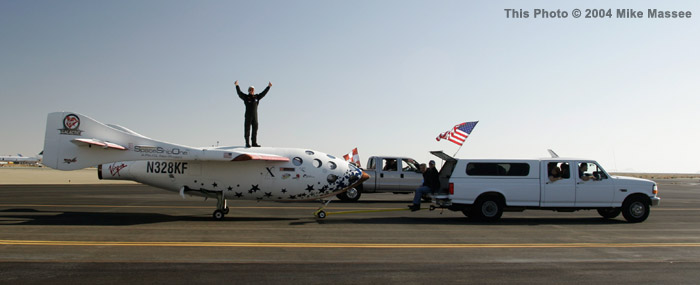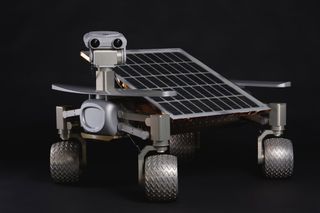
SAN MATEO, Calif. — The organization whose big-money prizes helped get the private spaceflight industry off the ground isn't done issuing high-profile challenges to spur exploration of the final frontier.
The nonprofit X Prize Foundation, which awarded $10 million to a groundbreaking private spaceship in 2004 and is currently offering $30 million in prize money for a private race to the moon, will be announcing further spaceflight challenges in the future, said Gregg Maryniak, the organization’s corporate secretary.
However, those challenges are “not at a sufficient level of cooking to be discussed," Maryniak said here Sunday (May 19) at Maker Faire Bay Area, a two-day festival celebrating DIY science, engineering and technology. [The Top 10 Private Spaceships]
"Watch for more for sure, because our original passion was about using space to save the Earth," Maryniak added.
The power of prizes
Prizes have great power to focus the efforts of talented and creative people, potentially effecting tremendous change, Maryniak said.
As an example, he pointed to the impact of a $25,000 prize (more than $300,000 in today's dollars) that New York hotel owner Raymond Orteig offered in 1919 to the first aviator who could fly nonstop from New York to Paris, or vice versa.
Get the Space.com Newsletter
Breaking space news, the latest updates on rocket launches, skywatching events and more!
American pilot Charles Lindbergh famously won the prize in 1927 with his plane Spirit of St. Louis, changing the course of aviation history in one celebrated flight.
Within one year of Lindbergh's flight, "the number of pilots in America triples, the number of airplanes in America quadruples and the number of people buying tickets to go on commercial flights went up thirtyfold," Maryniak said.
Spurring commercial spaceflight
The X Prize Foundation wanted to jump-start commercial spaceflight the way Orteig boosted aviation. So, in 1996, the organization announced the Ansari X Prize, which offered $10 million to the first private team to launch a manned spacecraft to an altitude of 62 miles (100 kilometers) twice within a two-week span.
Scaled Composites won the prize in 2004 with its SpaceShipOne, which Virgin Galactic subsequently developed into the suborbital commercial vehicle SpaceShipTwo. SpaceShipTwo made its first rocket-powered test flight last month and may start carrying paying customers before the end of the year.
And Virgin Galactic is not the only player in commercial suborbital spaceflight. Another company, XCOR Aerospace, may begin operational flights of its Lynx rocket plane at about the same time.

"So we not only added a new ship to the livery of vehicles designed by humanity to get folks into space, but we also kicked off a whole new industry," Maryniak said.
Then, in 2007, the organization announced the Google Lunar X Prize, a contest to land a robot on the moon's surface, have it travel at least 1,650 feet (500 meters), and send data and images back to Earth.
The first privately funded team to do all of this by the end of 2015 will receive the $20 million grand prize. An additional $10 million is set aside for second place and various special accomplishments, such as detecting water — bringing the prize's total price tag to $30 million. At present, 23 teams remain in the running.
The X Prize Foundation also offers prizes in other fields, from energy and the environment to education and global development.
Possible future X Prizes
Although Maryniak affirmed that more space-related X Prizes are in the offing, he declined to give any details. But the organization's website lays out a few possibilities as "concepts under consideration."
One of these is a "Synthetic Astrobiology X Prize," which would encourage the development of designer organisms that could aid human exploration of Mars. Other possible prizes could focus on the deflection of dangerous asteroids; the cheap and efficient removal of space junk; and reduction in the cost of suborbital research flights.
"Developing a very-low-cost, robust capability to take scientific instruments to the edge of space (200,000 feet) on a dedicated basis will shepherd in a new era of low-cost flight for academic and corporate R&D," the X Prize website states.
Follow Mike Wall on Twitter @michaeldwall and Google+. Follow us @Spacedotcom, Facebook or Google+. Originally published on SPACE.com.
Join our Space Forums to keep talking space on the latest missions, night sky and more! And if you have a news tip, correction or comment, let us know at: community@space.com.

Michael Wall is a Senior Space Writer with Space.com and joined the team in 2010. He primarily covers exoplanets, spaceflight and military space, but has been known to dabble in the space art beat. His book about the search for alien life, "Out There," was published on Nov. 13, 2018. Before becoming a science writer, Michael worked as a herpetologist and wildlife biologist. He has a Ph.D. in evolutionary biology from the University of Sydney, Australia, a bachelor's degree from the University of Arizona, and a graduate certificate in science writing from the University of California, Santa Cruz. To find out what his latest project is, you can follow Michael on Twitter.










